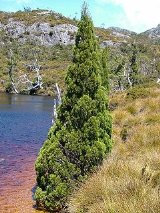
Athrotaxis cupressoides
Encyclopedia
Athrotaxis cupressoides is a species of Athrotaxis
, endemic to Tasmania
in Australia
, where it grows at 700–1,300 m altitude.
Its common name is Pencil Pine, although it's not a member of the Pine
family.
It is an evergreen
coniferous
tree
growing to 10–20 m tall, with a trunk up to 1 m diameter. The leaves
are scale-like, 3–6 mm long and 2–3 mm broad, arranged spirally on the shoots. The seed cones
are globose, 10–16 mm diameter, with 10–16 spirally-arranged scales; they are mature about six months after pollination. The pollen cones are 3–5 mm long.
The species is threatened, with the major cause of decline being out-of-control bushfires set to clear logging debris after timber harvests in nearby Eucalyptus
forests; a large proportion of the species' range was severely affected by major fires in 1960–1961. Disease caused by Phytophthora
species has also been identified as a cause of dieback. Regeneration is also hampered by introduced sheep and rabbit
s.
Away from its native range, it is occasionally cultivated as an ornamental tree in northwestern Europe
.
Athrotaxis
Athrotaxis is a genus of two to three species of conifers in the cypress family, Cupressaceae. The genus is endemic to western Tasmania, where they grow in high altitude temperate rainforests....
, endemic to Tasmania
Tasmania
Tasmania is an Australian island and state. It is south of the continent, separated by Bass Strait. The state includes the island of Tasmania—the 26th largest island in the world—and the surrounding islands. The state has a population of 507,626 , of whom almost half reside in the greater Hobart...
in Australia
Australia
Australia , officially the Commonwealth of Australia, is a country in the Southern Hemisphere comprising the mainland of the Australian continent, the island of Tasmania, and numerous smaller islands in the Indian and Pacific Oceans. It is the world's sixth-largest country by total area...
, where it grows at 700–1,300 m altitude.
Its common name is Pencil Pine, although it's not a member of the Pine
Pinaceae
Pinaceae are trees or shrubs, including many of the well-known conifers of commercial importance such as cedars, firs, hemlocks, larches, pines and spruces. The family is included in the order Pinales, formerly known as Coniferales. Pinaceae are supported as monophyletic by its protein-type sieve...
family.
It is an evergreen
Evergreen
In botany, an evergreen plant is a plant that has leaves in all seasons. This contrasts with deciduous plants, which completely lose their foliage during the winter or dry season.There are many different kinds of evergreen plants, both trees and shrubs...
coniferous
Pinophyta
The conifers, division Pinophyta, also known as division Coniferophyta or Coniferae, are one of 13 or 14 division level taxa within the Kingdom Plantae. Pinophytes are gymnosperms. They are cone-bearing seed plants with vascular tissue; all extant conifers are woody plants, the great majority being...
tree
Tree
A tree is a perennial woody plant. It is most often defined as a woody plant that has many secondary branches supported clear of the ground on a single main stem or trunk with clear apical dominance. A minimum height specification at maturity is cited by some authors, varying from 3 m to...
growing to 10–20 m tall, with a trunk up to 1 m diameter. The leaves
Leaf
A leaf is an organ of a vascular plant, as defined in botanical terms, and in particular in plant morphology. Foliage is a mass noun that refers to leaves as a feature of plants....
are scale-like, 3–6 mm long and 2–3 mm broad, arranged spirally on the shoots. The seed cones
Conifer cone
A cone is an organ on plants in the division Pinophyta that contains the reproductive structures. The familiar woody cone is the female cone, which produces seeds. The male cones, which produce pollen, are usually herbaceous and much less conspicuous even at full maturity...
are globose, 10–16 mm diameter, with 10–16 spirally-arranged scales; they are mature about six months after pollination. The pollen cones are 3–5 mm long.
The species is threatened, with the major cause of decline being out-of-control bushfires set to clear logging debris after timber harvests in nearby Eucalyptus
Eucalyptus
Eucalyptus is a diverse genus of flowering trees in the myrtle family, Myrtaceae. Members of the genus dominate the tree flora of Australia...
forests; a large proportion of the species' range was severely affected by major fires in 1960–1961. Disease caused by Phytophthora
Phytophthora
Phytophthora is a genus of plant-damaging Oomycetes , whose member species are capable of causing enormous economic losses on crops worldwide, as well as environmental damage in natural ecosystems. The genus was first described by Heinrich Anton de Bary in 1875...
species has also been identified as a cause of dieback. Regeneration is also hampered by introduced sheep and rabbit
European Rabbit
The European Rabbit or Common Rabbit is a species of rabbit native to south west Europe and north west Africa . It has been widely introduced elsewhere often with devastating effects on local biodiversity...
s.
Away from its native range, it is occasionally cultivated as an ornamental tree in northwestern Europe
Europe
Europe is, by convention, one of the world's seven continents. Comprising the westernmost peninsula of Eurasia, Europe is generally 'divided' from Asia to its east by the watershed divides of the Ural and Caucasus Mountains, the Ural River, the Caspian and Black Seas, and the waterways connecting...
.

